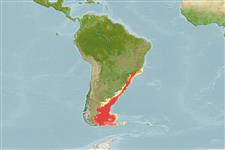Preferred temperature (Ref.
115969): 4.5 - 18, mean 6.3 (based on 214 cells).
Phylogenetic diversity index (Ref.
82804): PD
50 = 0.5000 [Uniqueness, from 0.5 = low to 2.0 = high].
Bayesian length-weight: a=0.00479 (0.00401 - 0.00571), b=3.09 (3.04 - 3.14), in cm Total Length, based on LWR estimates for this species (Ref.
93245).
Trophic level (Ref.
69278): 4.0 ±0.61 se; based on food items.
Widerstandsfähigkeit (Ref.
120179): niedrig, Verdopplung der Population dauert 4,5 - 14 Jahre. (K=0.13-0.19; tm=6).
Prior r = 0.42, 95% CL = 0.27 - 0.62, Based on 4 data-limited stock assessments.
Fishing Vulnerability (Ref.
59153): High vulnerability (61 of 100).
Climate Vulnerability (Ref.
125649): Moderate vulnerability (44 of 100).
